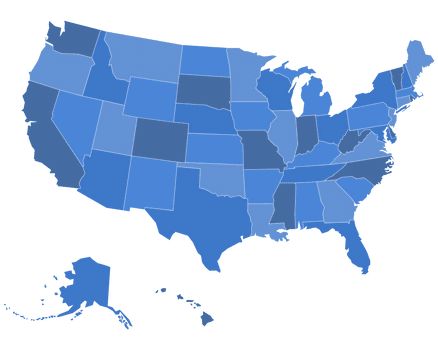Alaska Car Shipping
Vehicle Shipping to and from Alaska
How to ship a car to Alaska
Car shipping to or from Alaska is not as simple as driving it to the destination, but it can be done with the help of Beeline Auto Transport. Before embarking on this journey, it’s essential to consider all the details, such as the location of your origin and destination, as well as the time of year. These factors will help you choose the right transport options while keeping costs under control.
We can transport your vehicle between Alaska and the mainland, using ships for the safest and fastest delivery. Our shipping ports are the Port of Alaska in Anchorage, AK, and the Port of Tacoma in Tacoma, WA. While most of our Alaska car shipping is done on an open deck, we also offer closed deck options for those who need their vehicles fully protected in a climate-controlled area.
Our team makes the process of shipping your vehicle to or from Alaska stress-free by handling all the details and paperwork for you. All you need to do is drop off or pick up your vehicle at either of the two ports. If that’s not possible, we can truck your vehicle to or from either of the ports. While we offer driven transport in all of the mainland, note that we only provide trucking options in Alaska between Fairbanks and Anchorage.
Ships leave the ports twice a week, so when you drop off your vehicle, rest assured that it will be safely loaded onto one of the ships setting sail that week. As soon as the ship leaves the port, your vehicle is typically be delivered to the other port within a week.


Alaska car shipping To Dos & checklist
- Please don’t leave any personal belongings behind as they can pose a safety and liability concern.
- Make sure you have no more than a 1/4 tank of gas in the tank.
- Vehicles should be delivered in clean condition inside and out.
- Make sure your vehicle is in good running condition and perform standard maintenance checks such as checking fluid levels, tire pressure, and battery charge, as well as ensuring there are no fluid leaks.
- Passenger-type vehicles (sedans, SUVs, passenger vans, station wagons) have maximum dimensions of 21’8″ long, 8′ wide, and 7′ high.
- Remove any fire extinguishers, if you have them.
- All vehicles with propane tanks should be delivered with empty tanks.
How much does Alaska car shipping cost?
When it comes to Alaska car shipping, the cost can vary based on a multitude of factors. Every vehicle and route is unique, which is why consulting with a transport specialist is crucial to get an accurate estimate.
While online car shipping cost calculators can be convenient, they may not always provide an accurate representation of the final cost.
It’s also important to be cautious of lowball prices, as they could potentially hide additional fees or lead to unexpected price increases after signing the contract.
By working closely with a transport expert, you can ensure a smooth and transparent car shipping process to/from Alaska without any surprises along the way.
| Type of car | The shipping cost is influenced by the type of car that you want to transport. Larger car or trucks cost more to transport than smaller cars. |
| Car condition | The shipping process is impacted by the overall condition of your car. Inoperable vehicles call for extra equipment and labor to ensure secure transportation. Vehicles unable to independently drive onto carriers will need specialized equipment such as a winch for loading and unloading. |
| Distance | The distance of the shipment is one of the main factors in calculating the cost of Alaska car shipping. Longer distances typically result in higher costs because of the increased fuel and labor needed. |
| Pickup and delivery locations | For Alaska car shipping, transporting from port to port is more cost-effective than delivering directly to a home address at either end. Needing transport to or from the port will add on to the final price. |
| Type of transport | The method of transport or type of carrier influences the overall cost. Open transport will be more cost-effective. Enclosed transport, where vehicles are shipped in closed containers, is pricier but provides better protection. |
| Seasonal fluctuations | Seasonal variations greatly impact Alaska car shipping costs. High demand during peak summer months can lead to price hikes. Conversely, lower demand in the off-season may result in reduced prices. |
| Fuel price | Fluctuations in fuel prices can directly impact the overall cost of transporting a vehicle. Higher fuel prices can result in increased shipping costs as carriers pass on these expenses to customers. On the other hand, lower fuel prices may lead to more competitive rates for car shipping services. |
The cheapest way to ship a car to or from Alaska
So what is the best way to keep Alaska car shipping cost to a minimum? If you keep a few things in mind, you can avoid unnecessary costs for transport.
Opt for open transport: The standard and most economical way to ship cars in the industry.
Ensure your car is operable: Carriers charge extra for handling inoperable vehicles, so make sure your car runs and drives.
Plan ahead: Booking in advance helps avoid expedited or last-minute fees.
Keep your schedule flexible: A flexible schedule often leads to more budget-friendly quotes.
Consider low-season transportation: Shipping a car is usually cheaper during winter compared to summer.
Choose major city locations for pickup and delivery: If you live in a rural area, arranging for car pickup and drop-off near a major city can be more cost-effective.
Transport multiple cars: Shipping more than one vehicle on the same truck can result in savings.
Inquire about discounts: Active military members, seasonal travelers, or repeat clients may be eligible for discounts.
Serving All 50 States
Including Hawaii and Alaska

Alabama — Alaska — Arizona — Arkansas — California — Colorado — Connecticut — Delaware — Florida — Georgia — Hawaii — Idaho — Illinois — Indiana — Iowa— Kansas — Kentucky — Louisiana — Maine — Maryland — Massachusetts — Michigan — Minnesota — Mississippi — Missouri — Montana — Nebraska — Nevada — New Hampshire — New Jersey — New Mexico — New York — North Carolina — North Dakota — Ohio — Oklahoma — Oregon — Pennsylvania — Rhode Island — South Carolina — South Dakota — Tennessee — Texas — Utah — Vermont — Virginia — Washington — West Virginia — Wisconsin — Wyoming
Got more questions?
We can help.

